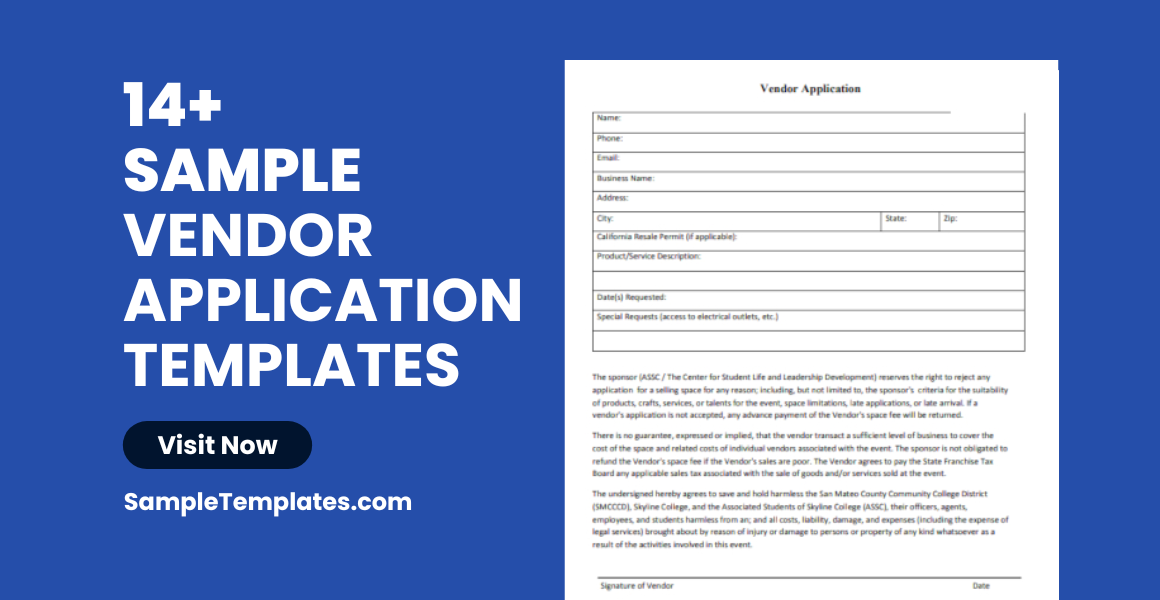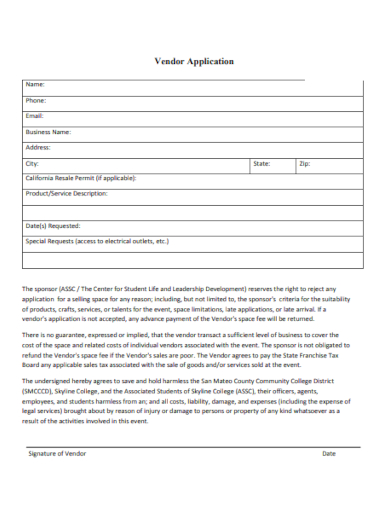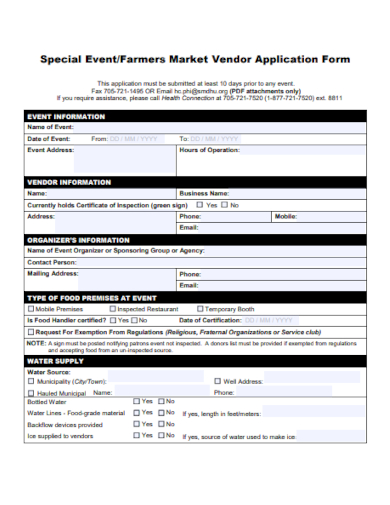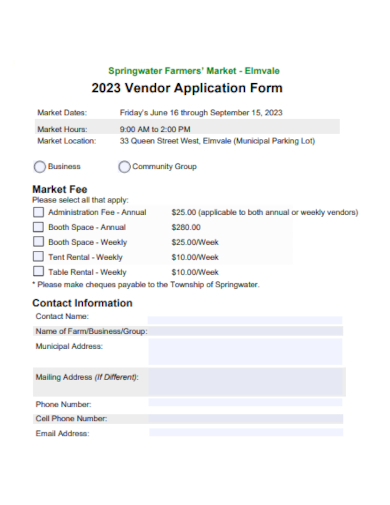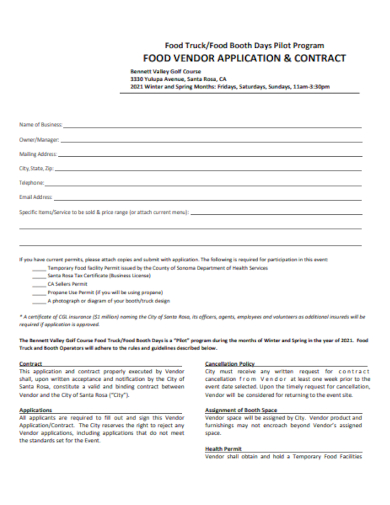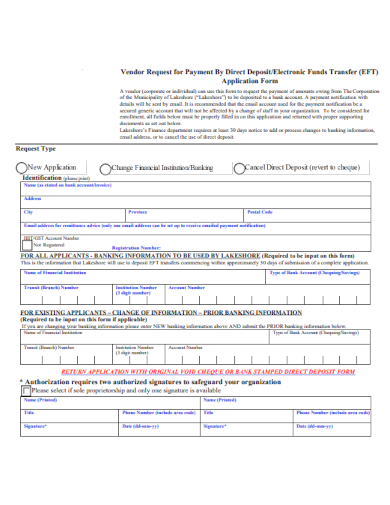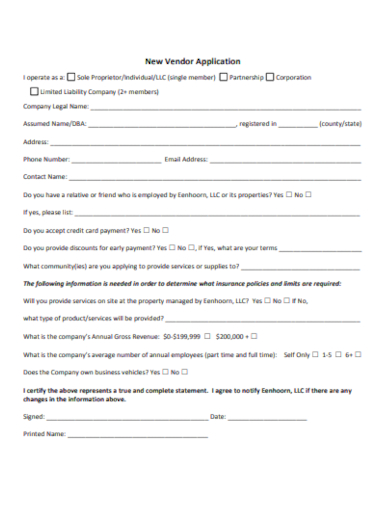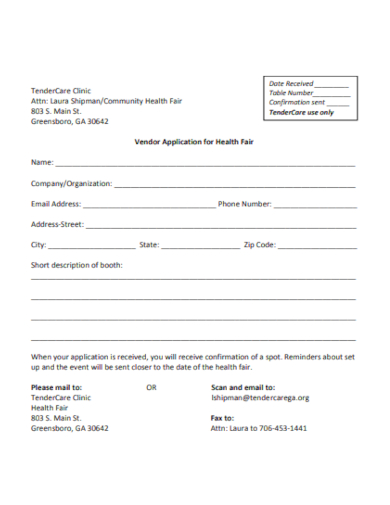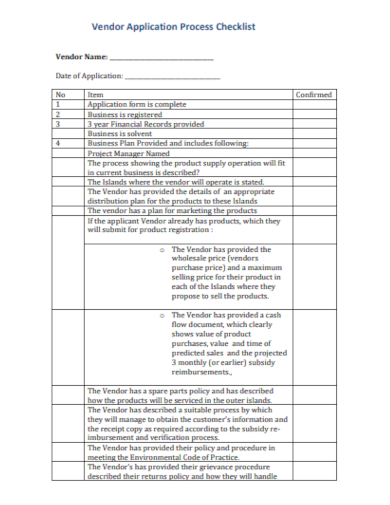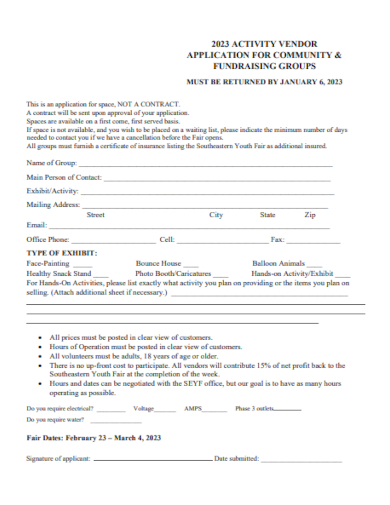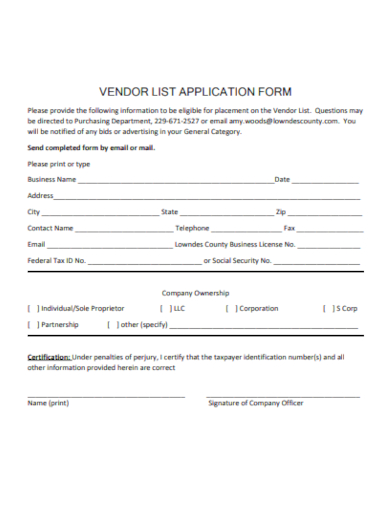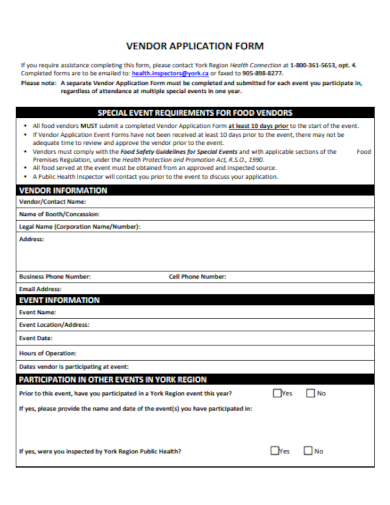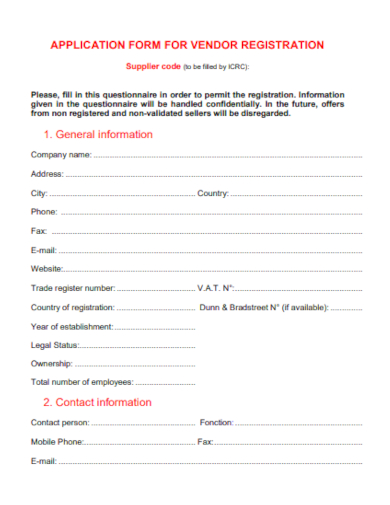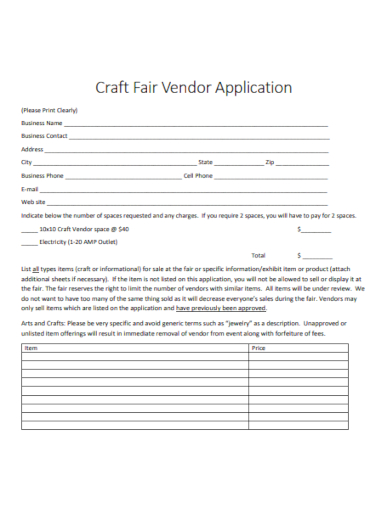In the realm of business partnerships, selecting the right vendor can be a transformative decision. The ‘Vendor Application’ stands as a pivotal tool in this process, offering a comprehensive overview of potential partners. This design document elucidates critical details, qualifications, and capabilities of vendors, ensuring businesses can make informed choices. By harnessing this Vendor Application template, organizations can sift through contenders effectively, ensuring only the most competent and aligned vendors are considered. Navigate through to find the best fit for your business needs.
14+ Vendor Application Samples
1. Sample Vendor Application Template
2. Sample Vendor Application Form Template
3. Sample Event Vendor Application Template
4. Sample Farmers Market Vendor Application Template
5. Sample Food Vendor Application Template
What is a Vendor Application?
Understanding the Basics
A vendor application is a formal document that businesses or individuals fill out to apply to be a vendor or supplier for an sample event, retail store, or any organization seeking external products or services. This application helps event organizers or business entities assess if a prospective vendor aligns with their needs and standards.
Why Vendor Applications are Crucial
- Streamlining the Selection Process: Vendor applications simplify the process of selecting suitable vendors by collating all necessary information in one place.
- Setting Clear Expectations: They lay out the requirements and conditions that vendors must meet, ensuring both parties are on the same page.
- Maintaining Quality Control: Through these applications, organizers can ensure that only high-quality vendors who meet specific criteria participate.
Key Components of a Vendor Application
- Business Details: This section usually asks for the vendor’s business name, address, contact details, and sometimes, a sample brief history or overview.
- Products or Services Offered: Vendors provide a sample list or description of what they offer, ensuring it aligns with the event or business needs.
- Licenses and Certifications: Some applications may require proof of certain licenses or certifications, especially if it’s related to food, health, or other regulated industries.
- Previous Experience: Vendors might be asked about past events they’ve participated in or businesses they’ve supplied to, providing a track record of their experience.
The Digital Age: Online and Fillable Vendor Applications
In today’s tech-savvy world, many organizations have moved away from traditional sample paper applications to online, fillable vendor application forms. These digital versions offer:
- Ease of Access: Vendors can access and fill out the form from anywhere.
- Quicker Processing: Automated systems can quickly sort and analyze digital applications.
- Eco-friendliness: Reducing paper usage is a boon for the environment.
Tips for Filling Out a Vendor Application
- Read All Instructions Carefully: Ensure that you understand all the requirements before starting.
- Be Precise: Provide clear and concise answers. Avoid fluff.
- Gather All Necessary Documents: Having all required documents on hand, such as licenses, will make the process smoother.
- Follow Up: After submitting, it’s a good practice to follow up to confirm sample receipt and inquire about the next steps.
The Evolution of Vendor Applications
Over the years, the way organizations and businesses interact with vendors has seen a tremendous shift. Vendor applications, once a mere formality, have now transformed into a strategic tool.
- From Paper to Digital: The journey of vendor applications from paper professional forms to digital platforms reflects the broader trend of digital transformation in business processes.
- Tailored Applications: As markets become more niche, vendor applications too have evolved to cater to specific industries and their unique requirements.
Importance of Customizing Vendor Applications
Not all events or businesses have the same needs. Recognizing this, the customization of vendor applications has grown in significance.
- Industry-Specific Queries: For instance, a tech expo would have different criteria and questions for vendors compared to a food festival.
- Setting the Tone: A well-designed application can communicate the ethos and standards of the organizing body, setting the stage for future interactions.
Vendor Application Mistakes to Avoid
Every vendor aims to put their best foot forward when applying. However, some common pitfalls can hinder their chances.
- Over-Promising and Under-Delivering: It’s crucial for vendors to be truthful about their capabilities.
- Ignoring the Fine Print: Many applications have terms and conditions attached. Overlooking these can lead to misunderstandings later.
- Missed Deadlines: Often, there’s a window for submitting applications. Missing this can mean missed opportunities.
Post-Application: What Next?
Once the vendor application is submitted, the process doesn’t end there.
- Assessment by Organizers: The organizing entity will usually have a sample review process to evaluate all applications.
- Interview or Further Scrutiny: Some organizers might conduct interviews or ask for demonstrations, especially for high-stake or long-term collaborations.
- Feedback Loop: Whether accepted or rejected, constructive feedback can help vendors improve and refine their offerings.
Why Do I Need a Vendor Application?
In the dynamic world of business, vendor applications have transitioned from being a simple formality to an essential strategic tool. If you’re an organizer, retailer, or a business entity considering vendors for your operations or events, understanding the value of a vendor application is crucial. But why exactly do you need one? Let’s delve into the reasons.
1. Streamlined Vendor Management
- Centralized Information: Vendor applications serve as a repository for all pertinent information regarding a vendor. This makes it easy to assess, compare, and manage multiple vendors simultaneously.
- Efficient Selection: With a standard format for all applications, you can quickly identify and shortlist vendors who meet your specific criteria, ensuring consistency in the selection process.
2. Quality Assurance and Risk Mitigation
- Setting Standards: Through the application process, you set a benchmark for the quality and type of vendors you wish to collaborate with.
- Verifying Credentials: Asking for certifications, licenses, and references helps you ascertain the credibility and reliability of the vendor, reducing potential risks.
3. Clear Communication and Expectation Setting
- Defining Roles: Vendor applications can specify what you expect from the vendor and what they can anticipate in return.
- Resolving Ambiguities: A comprehensive application can address potential questions and uncertainties vendors might have, ensuring clarity from the get-go.
4. Financial and Legal Protections
- Due Diligence: By vetting potential vendors thoroughly, you safeguard your business from potential financial losses due to unfulfilled contracts or subpar goods and services.
- Legal Compliance: Vendor applications can help ensure that your vendors adhere to local regulations and industry standards, preventing potential legal complications.
5. Building Long-Term Relationships
- Mutual Understanding: A clear and transparent application process lays the foundation for a strong working relationship built on mutual respect and understanding.
- Feedback Mechanism: The application process can also serve as an initial sample feedback tool. Vendors can get a sense of your business’s professionalism, while you can gauge their responsiveness and eagerness to collaborate.
6. Facilitating Growth and Scalability
- Database Creation: As your business grows, having an organized database of vendors, initiated from their applications, can be invaluable. This can streamline future events or expansions.
- Attracting Top Vendors: A well-structured application process can enhance your reputation in the market, attracting high-quality vendors seeking serious collaborations.
6. Sample Vendor Request for Payment Application
7. Sample New Vendor Application Template
8. Sample Vendor Application for Health Fair Template
9. Sample Food Truck Vendor Application Template
10. Sample Vendor Application Process Checklist
11. Sample Community Fundraising Vendor Application
12. Sample Vendor List Application Form Template
13. Sample Basic Vendor Application Template
14. Sample Vendor Registration Application Template
15. Sample Craft Fair Vendor Application Template
How do you Create a Vendor Application?
Creating a vendor application form is an essential step for businesses that want to establish a structured process for sample onboarding new vendors or suppliers. A well-designed vendor application will help in gathering relevant information, ensuring compliance, and establishing a basis for future negotiations and collaborations. Here’s a step-by-step guide to creating a vendor application in five detailed steps:
Step 1: Define Vendor Basics and Business Details
Begin with sections to gather fundamental details about the vendor. This includes the vendor’s business name, type of business (corporation, sole proprietorship, etc.), main contact person, business address, email, phone number, website, and the date of establishment. This foundational information helps in establishing the vendor’s identity and offers insight into their scale and longevity in the market.
Step 2: Product or Service Description
This section should delve into what the vendor is offering. Ask for detailed descriptions of the products or services they provide. For products, specifications, models, available quantities, and delivery sample timelines might be pertinent. For services, methodologies, team qualifications, previous projects, and delivery mechanisms would be important. Understanding the vendor’s core competencies will allow you to gauge if they align with your needs.
Step 3: Financial and Legal Information
For due diligence, it’s crucial to gather financial and legal details. Request tax identification numbers, bank details for payments, and references from other businesses they’ve worked with. You might also want to know about any pending or past litigations or disputes. Some companies also ask for financial statements to ascertain the vendor’s financial stability. Ensure that they comply with local and international regulations, especially concerning labor laws, environmental standards, and other relevant industry-specific norms.
Step 4: References and Past Engagements
Inquire about their previous or existing clients, especially those similar to your business or industry. This helps in understanding the vendor’s experience and reputation in the market. Ask for case studies, testimonials, or direct references. Speaking to these references can provide insights into the vendor’s reliability, quality of products/services, and responsiveness to issues or challenges.
Step 5: Terms, Conditions, and Certifications
End the application by listing out any specific terms and conditions that the vendor should be aware of before starting the relationship. This could include payment terms, return policies, maintenance services, or confidentiality agreements. Also, inquire about any certifications they hold, such as ISO standards or industry-specific qualifications, as these can be indicative of the vendor’s commitment to quality and best practices.
In Conclusion, a vendor application, while seemingly straightforward, plays a pivotal role in bridging vendors with opportunities. For businesses or events seeking vendors, it offers a structured way to assess potential collaborators. For vendors, it’s a gateway to new business opportunities. In this digital age, the transition to online applications has further streamlined the process, making it easier for both parties. Like any formal document, attention to detail and thoroughness are key when filling one out.
Related Posts
FREE 29+ Student Application Form Samples in PDF | MS Word
FREE 21+ Administrative Application Samples in MS Word | Apple Pages | PDF
FREE 21+ Teacher Application Samples in MS Word | Apple Pages | Outlook | PDF
FREE 25+ Transfer Application Samples in MS Word | Apple Pages | PDF
FREE 23+ Participation Application Samples in MS Word | PDF
FREE 14+ Patient Application Samples in MS Word | PDF
FREE 21+ Eligibility Application Samples in PDF
FREE 20+ Travel Application Samples in PDF | MS Word
FREE 25+ Sponsor Application Sampales in MS Word | Google Docs | Apple Pages | PDF
FREE 23+ Candidate Application Samples in PDF
FREE 33+ Committee Application Samples in PDF | MS Word
FREE 37+ Supplemental Application Samples in PDF | MS Word
FREE 37+ Product Application Samples in PDF | MS Word
FREE 33+ Visiting Application Samples in PDF | MS Word
FREE 34+ Refund Application Samples in PDF | MS Word
